This web page describes a trip with the traditional Greek Perama S/Y Faneromeni from Mitilini on the Greek island of Lesvos to Çanakkale in Turkey. The places visited, all in Turkey, are: Ayvalik, Tenedos (Bozcaada), Çanakkale, Troy, and Callipoli. It is illustrated with maps and photographs, also included are some historical and geographical descriptions of the places visited as well as several links to other related web sites.
Note: A portion of his passage is also described by my brother Nikos Riginos in his Faneromeni website.
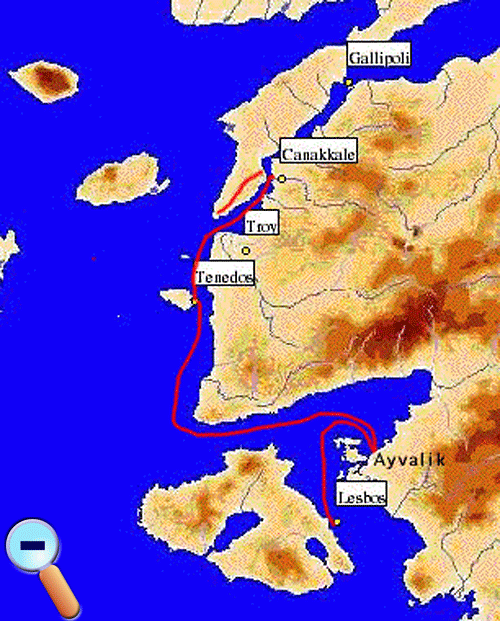
Sunday May 31, 1998
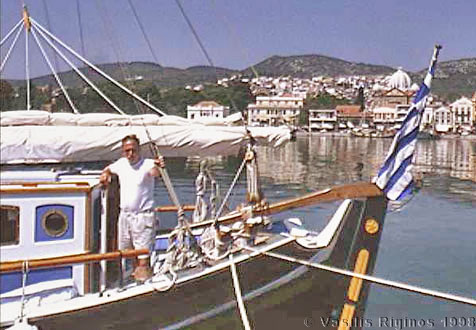
I flew to the island of Lesvos and met my brother Nikos Riginos and his girlfriend Rozina in the Mitilini harbor lounging on the Faneromeni together with Argos, Nikos’ ancient dog, and Naxos, their new puppy, adopted this spring on the island of Naxos.
In the late afternoon Rozina and Naxos departed with the ferry boat for Athens. Argos, in the meantime, went for a stroll in the harbor and disappeared. After a few hours there was no sign of him and we panicked since we wanted to sail early in the morning for Ayvalik. We searched all over to no avail. Nikos was beside himself because Argos is over 15 years old and his senses are not what they used to be so he may not find his way back to the boat. In desperation Nikos rented a motorbike so that he could search for Argos in a wider area. I, in the meantime, stayed on board in a nice director’s chair watching the comings and goings of the harbor while nursing a glass of ouzo, just in case Argos found his way back. Sure enough an hour after Nikos went searching with the motorbike, Mr. Argos came on-board as if nothing had happened and sat next to me wagging his thick tail.
After Nikos returned, we walked to the other end of the harbor to a fish restaurant and had some fresh grilled μουρμούρες (mourmoures, gray striped fish).
Monday June 1, 1998 Day 1
I went ashore for some light shopping while Nikos visited the authorities to get clearance out of Greece. Customs charged us 12,000 GRD for a “boat inspection fee,” of course no one inspected the boat and we did not insist on it either.
We departed Mitilini at 1100 and we arrived in Ayvalik [39° 18.9' N 26° 41.3' E] at 1335 after 25 uneventful nautical miles (M) motoring all the way. During the trip I connected my Apple Powerbook computer with the new HP340 printer and printed a few copies of our crew list for the Turkish authorities.
Ayvalik is situated in an almost land locked lagoon formed by the heavily wooded mainland and the rather bare Alibey Adasi (Moschonisi). Ayvalik, like a lot of the towns and villages of the Asia Minor Aegean coast, used to be a Greek town until 1923 when the great population exchange between Greece and Turkey took place. It Greek name was Aivali. The name is Turkish and means a place with quinces. It was inhabited in Hellenistic, Roman, and Byzantine times but only few remains of those times have been found. The modern town was founded around 1580 by a few Greek fishermen looking for a place safe from the Maltese and Barbary pirates. The area was fist mentioned in modern times by the famous 16th century Ottoman admiral Piri Reis in his book Kitab-i-Bahriye. The inhabitants of both Ayvalik and Alibey became very skilled seamen, trading with Romania in the Black Sea, and the region was quite prosperous until the Greek war of independence in 1821. It was then destroyed in retaliation by the Ottomans and the inhabitants fled to the islands of Psara and Aegina. Following the war many of the inhabitants returned and rebuilt the town. Alibey became a shipbuilding center for traditional caïques. The well known Modern Greek historian, painter, restorer of Byzantine icons, and writer, Photis Kontoglu, was born in Ayvalik. He wrote an extensive history of the region. In 1923, following the tragic Greek-Turkish war the Greek inhabitants were exchanged with Moslem inhabitants from Crete and Macedonia. The present town has 30,000 inhabitants and it is rather pleasant because it is off the usual tourist track. Last time we were here with S/Y Thetis we spent a few days and visited the near-by site of Pergamon.
In Ayvalik, as we were about to enter the marina (now operated by Setur, a Koç company) we were met by an attendant on an inflatable who guided us to a slip and literally gave us a mooring line, while he and two other attendants tied our stern lines. This is service! We were then met by Mr. Ertug Günay, the marina manager, who took care of everything, he even provided us with weather maps downloaded from the internet. He has lived for many years in the US and of course his English was impeccable. He told us that part of the marina fee also covers the handling of all the paperwork for entry into Turkey and that the fee for the transit log would be $50.
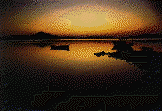
The attendant took the Faneromeni’s papers and our passports and went on his inflatable to get the necessary stamps. It was here that I made my big mistake. I have dual citizenship: Greek and US, and hence two passports. I usually use the Greek passport which makes entry in the EU countries totally hassle-free and avoids long lines. But since Turkey and Greece have rather tense relations I thought that it would be more prudent to use my US passport. So this is the passport that I gave to the attendant. Half an hour later he came back asking for $45 extra to cover the fee for my visa. It turns out that US citizens need a $45 visa while Greek and other EU citizens do not need a visa. This explains why last year in Datça we were charged so much for entering Turkey; we were not taken for a ride as I then thought, but since we gave 3 US passports we were charged an extra $75 (last year the visa fee was $25). Anyway, since I had neither US dollars nor Turkish liras but credit cards and traveler’s checks, we followed the attendant back to town with our inflatable so that I could get the necessary Turkish liras (TL) for the fee and other expenses.
When we arrived, the attendant showed me a bank with an automatic teller machine. Alas the AIS did not like either of my two credit cards. I went into the bank and stood in line. When my turn came they told me that they do not change dollars to liras and suggested another bank down the street. I found that bank and stood in line again. When my turn came I gave them two $100 traveler’s checks. Unfortunately the date on the checks was written using the US (where I had purchased them) convention of “month/day/year” instead of the more widely used “day/month/year.” The director had to be summoned. She decreed that while the checks were valid their date would have to be rewritten in the approved format and initialed by both of us. Next problem was that before the money could be changed they needed my passport which of course was being held by the passport office, until the visa fee got paid. Catch 22! No passport, no money! No money, no passport! I left the already signed and initialed checks at the bank and went to the passport office where I tried to explain my predicament, and begged them if I could I please borrow my passport for just a few minutes so that I could get the money to pay for the visa. Very reluctantly they agreed, provided that the marina attendant would hold the passport. Back to the bank. After typing what seemed to me a great deal of information at their computer, and after I had to sign at least four different forms, I got about 5 million TL in exchange for my $200. With a sigh of relief the attendant and I walked back to the passport office. Our problems unfortunately were far from being over. It turned out that the visa could not be paid in either TL or in Greek drachmas but had to be paid in US dollars, not in traveler’s checks, not with a credit card, but in hard cash which I did not have. The all-suffering attendant then led me to a jewelry store where at a usurious rate of exchange, I was able to change back TLs for USDs. Total elapsed time to appease the bureaucracy was 2½ hours during the hottest part of the day.
As it was already late afternoon and we were very hot and hungry, we sat at a cool waterfront restaurant and had a nice snack, and most importantly, a cold beer celebrating our arrival to Turkey.
Back on board I was able to focus on the technical problem that had been plaguing Nikos ever since he sailed from Athens. He had bought a Navtex receiver and had it installed by the dealer. The receiver had not received any signal while in the Glyfada marina, but the installer had assured him that this was an anomaly caused by the proximity of the marina to the Athens airport. Never mind that the same dealership had a year ago installed a Navtex receiver on Thetis moored right next to the Faneromeni which worked just fine, thank you very much. So, after the Faneromeni sailed some distance from Athens, the receiver continued not to receive. The dealer (our old friend Mr. Skordilis who also represents Autohelm in Greece) sent to Nikos, in Lesvos, a new unit, complete with a new antenna. Nikos climbed up the mast and replaced the old antenna with the new one and then we replaced the receiver. It still did not receive. I thought that since the only common denominator with the old arrangement was the antenna cable and the power connection the problem could be caused by interference from the 12 V power supply (Faneromeni has a 24 V system). So we made a temporary connection directly to the battery, bypassing the power supply. After a few hours we did receive one message and then nothing. Mystified, we connected the original receiver directly with the battery and replaced the antenna on top of the mast with the original one and left the unit on. Navtex signals are not continuous and several hours can separate the transmissions. We then turned our attention to the Faneromeni’s cellular telephone. After some time, reading the less-than-clear instructions, we managed to connect with a Turkish provider.
Later, after hot showers, we walked to the town for a light meal and another celebration of our arrival in Turkey.
Tuesday June 2, 1998 Day 2
We departed Ayvalik at 0655 for Bozcaada (Tenedos). The Navtex, although it was left on overnight, did not receive any signals. While on our way we continued trouble-shooting the Navtex. Just to make sure, we decided to measure the input voltage and verify that it was indeed 12 V. Nikos got out his multimeter, and to test its function, he inserted the leads to his 12 V plug. All 12 V power was lost. The multimeter shorted the 24 V to 12 V power supply. We connected the 12 V circuits directly to the battery, by-passing the power supply, and restored the 12 V service which powers the autopilot and all the instruments. Among the instruments affected by the loss of power was the cellular telephone. Despite prolonged efforts we could not bring it back into service. We were not sure whether it was damaged or we had missed a step in the complicated procedure of acquiring a signal from a foreign service provider. The Navtex did receive 12 V but did not receive any signals.
The sea was very calm and while Faneromeni was motoring we cooked pasta with tuna fish for lunch, which we ate on deck.
We arrived in Tenedos (Bozcaada) [39° 50.1' N 26° 04.6' E] at 1430, having motored 57.8 M. The harbor is very attractive, with clear water, and it was not crowded. We moored sideways without any difficulty. Before we even finished tying our lines an official appeared and after we secured the boat he escorted us to the “Harbor Master” who held office in the yard of an old house shaded by a blooming bougainvillea. He was very friendly and spoke some Greek while one of his underlings spoke some English. So our conversation was a mixture of Greek, English translated into Turkish, lots of hand gestures and smiles. Bozcaada used to be a military zone and private yachts were discouraged, but now they are trying to encourage tourism. After half an hour of drinking çay (tea) and talking good-will small talk he looked at our boat papers in an off-hand way and he was very relieved to see that they were all in order. He wished us a good stay and offered his services for anything that we might need. It definitely was more of a social call than an official visit.
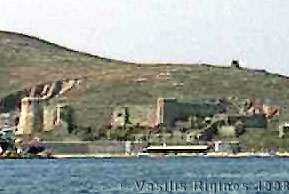
Tenedos is a small island with a long history. In ancient times it was associated with Apollo and the Trojan war, when the Greeks used it as base. It was here that they retired after leaving the Trojan horse as a “gift.” During the Byzantine times it was used as a grain depot so that large ships could unload their grain and not go to Constantinople through the Dardanelles. The large castle that dominates the small town was built by the Genoese during the end of the Byzantine era. During modern times it was inhabited by Greeks and it was part of Greece until 1923 when it was ceded to Turkey under the terms of a peace treaty. The Greek inhabitants were not exchanged but were allowed to stay and operate their schools and churches. Over the years most Greeks have left. The island is well known for its vineyards and production of wine.
The water in the harbor was very clear and attractive so I jumped overboard, to be followed by Argos. It was very refreshing, so refreshingly cold that I could not swim for more than a few minutes.
Later a young man came by the boat and spoke to us in very good Greek. His name was Panayiotis and he was one of the two young men out of the remaining 30 Greek inhabitants. He lives with his parents, wife, and young son here in Tenedos, while his brother is living in Athens. He kindly offered to give us a tour of the town.
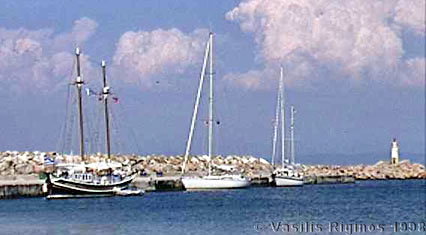
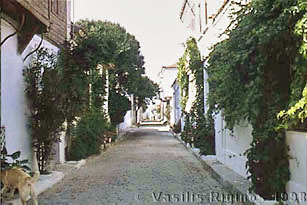
We first tried to visit the large Genoese castle but it was closed despite the posted hours indicating that it should be open for another hour. Panayiotis gave us a walking tour of the small town, pointing to us every abandoned Greek house. Many of these houses are quite substantial and are now being purchased by people from Istanbul who are restoring them for use as summer houses. He took us to the Greek school, which he attended as a boy, and which has now been converted into a modest but attractive hotel. The hotel owner, a Turkish gentleman who has lived for a year in Australia, proudly showed us the restaurant and a few guest rooms.
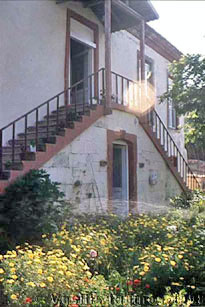
The relations between the remaining Greeks and the Turkish inhabitants appear to be amiable but nevertheless most Greeks have fled in fear during periods of increased Greek-Turkish hostilities such as the many Cyprus-related crises. Panayiotis himself has served in the Turkish army and feels that as a Turkish citizen he is entitled to, and gets, all the privileges. He does not feel that he is being discriminated against. These feelings, however, are not shared by the older folk. We met his mother and wife and son in front of their house. Strangely we were not invited in. We also met the Greek priest, in civilian clothes, as he was returning from his fields. We also met Panayiotis’ father, a splendid old man, at the kafeneion.
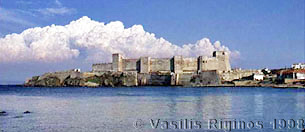
The Castle |
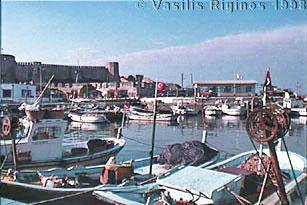
The Harbor |
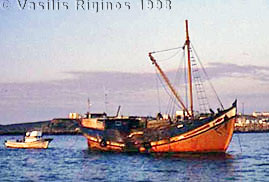
Back on board, Nikos managed, using a portable cellular phone, to call Mr. Skordilis in Athens about the Navtex. Mr. Skordilis had contacted the manufacturer in England but he did not have any new suggestions on what to do. We then attacked the problem of the head of the starboard cabin which did not pump a sufficient amount of water to flush effectively. We took it apart and tested the pump separately but could not find the cause of the problem other then to verify that the pump was operating but did not provide high pressure. Possibly the impeller was slipping from its axle. Not having a new impeller, we reassembled the head.
By the time we had finished all these tasks it was almost 10 PM. We took quick showers and joined the anxious Panayiotis, who was waiting for us to go to his friend’s restaurant for dinner. It was a very modest meal as there were not too many offerings. At the restaurant we met a civil official from Çanakkale. We had seen the fellow earlier, dressed in a brown suit and necktie and we had speculated on his status. He explained, via Panayiotis’ translation, how much he admires the Greek traditions and culture and how much he willed both our nations to be friendly and have good relations. We, too, expressed similar sentiments and our sincere wishes for a better and more amiable future. We all drank to the fulfillment of this wish.
Wednesday June 3, 1998 Day 3
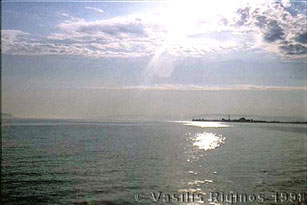
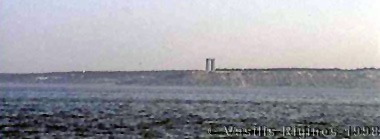
We left for Çanakkale at 0610. The water was very calm and there was no wind at all, not even a prayer of a chance to sail. As we were approaching the Dardanelles we noticed something on the surface moving quite fast, leaving a sizable wake. We originally thought that it was either a large fish or a turtle and we changed course to investigate. It turned out that it was a large bag full of styrofoam tied with a thick rope and something underwater was towing it at a good speed. As we came even closer the rope got tangled with our rudder but we managed to disengage without any difficulty. We decided that it must be a very large fish at the other end of the line. With some difficulty, we launched the inflatable, matched speed, tied one of our lines to the mysterious line, and cut off the bag. We then used Faneromeni’s powerful windlass to raise whatever it was at the other end of the line. It was so powerful that it towed the Faneromeni at 2.5 knots against the 2 knot current for about one hour. In the meantime, we slowly raised about 30 m of the line. During this time sometimes the tension on the line would ease somewhat and at other times it would increase. When the angle of the line reached about 50°, the line parted, so we will never know for sure what was at the other end. We theorized that no fish, no matter how large, could tow the Faneromeni against the current at such a speed for 1 hr. We also speculated on a submarine but it was going too slowly and we doubted that a submarine, would stay submerged at 14 m depths that close to the entrance of the Dardanelles. A whale? Whales are very rare in the Aegean but not unheard off. Again could a whale tow us for an hour without surfacing to breath? Unfortunately this is something that will have to remain a mystery.
We arrived in Çanakkale [40° 09.3' N 26° 24.3' E] at 1056 after motoring 33.6 M. At the entrance of the harbor, the attendant, Ali, met us with his launch and directed us, he even pushed the bow of the Faneromeni with the launch to help her maneuver into the small harbor.
Çanakkale, which is located strategically on the south side near the narrowest point, 1.4 km wide, of the Dardanelles or Hellespont was build by Mehmet II in 1452 prior to his conquering of Constantinople. In ancient times, the Persian king Xerxes built a bridge to cross the strait on his campaign to conquer Greece and so did Alexander on his campaign to conquer Persia. Lord Byron swam across from here. Today Çanakkale is a bustling town of 55,000 inhabitants and the gateway to Troy and the Gallipoli monuments.
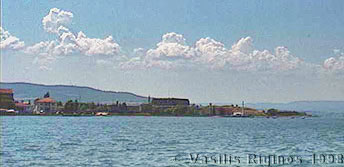
Photo of Çanakkale |
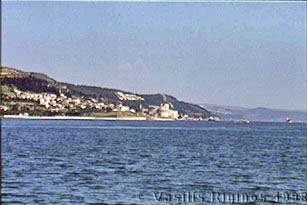
Kilitbahir (across Çanakkale) |
After securing the boat, we deployed Nikos’ folding Honda motorbike and we rode the 30 km to the site of ancient Troy (Trova). It is a confusing site with the many different cities uncovered, one on top of the other, spanning thousands of years. It is, of course, a great thrill to be stepping right over this legendary land. The little museum with a grotesque replica of the Trojan horse was a disappointment.
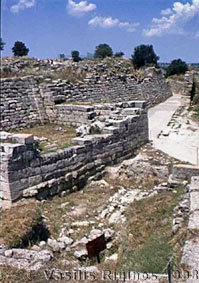
|
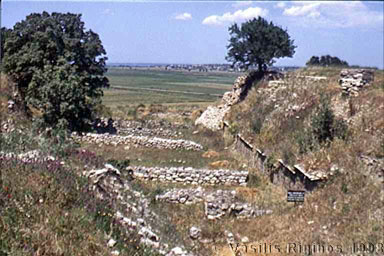
|
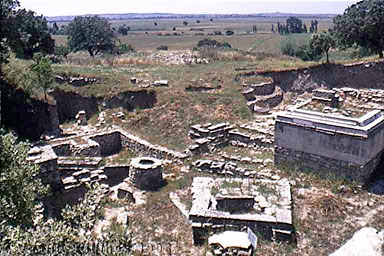
|
|
On the way back to Çanakkale we stopped at a restaurant with a magnificent view overlooking the Dardanelles and had pide (Turkish pizza) and chicken shish-kebab.
Back on board, once again, we removed the head and gave it to Ali, who seemed very capable and who assured us that he had an inventory of parts, including impellers, and would be able to repair the pump and have it ready before midnight. Ali lives with his wife and their lovely 9 year old daughter in his boat, an old caïque with iron cladding and many modifications. She looks very run down from the outside. Inside she is furnished with regular, heavy, house furniture and looks like a small floating bourgeois house.
We tried to visit the Military museum at the castle but it closes at 5:00 PM, so we did not make it. Nikos did some shopping for the boat while I rested on-board reading and sipping an ouzo.
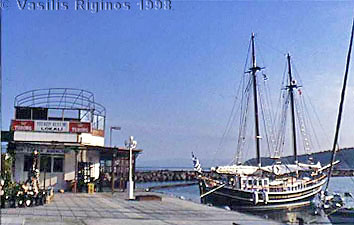
Later Ali came with two gentlemen, whom he introduced as medical doctors, who wanted very much to see the Faneromeni. We all had an ouzo and drank to better Greek-Turkish relations. I am always moved to see how many of the people we meet here are genuinely very friendly and wish that our countries would get along in friendship. I wish that both our governments would take the hint.
After Nikos hooked up his laptop and we sent and received our e-mail, he went to eat at the little restaurant next to the boat while I took a shower. By the time I joined him he was sitting with a gentleman engaged in deep conversation. The gentleman, whose name I do not recall, has a house and a store in Imbros (Gökceada) where he spends most of the year. We were then joined by Ali, who had finished repairing the head. We all had some wine and talked. Ali is quite a character. He left Turkey as a teenager and had all sorts of odd jobs in Germany, France, and Madeira, where he lived for over a year. He then landed a berth as a 3rd mate on the large American sailing yacht Silver Cloud. He sailed with her to the Caribbean and, via the Panama Canal, to California where he stayed for several years. He then crewed on a number of merchant ships in Asia. He finally settled back in Turkey after reaching his 45th birthday and started to search for a wife. The specifications were that she would like living on an old boat, she should scuba dive, and love the sea. He thinks that he has found her.
By the time we got back on-board it was well past 1 AM but Nikos wanted to test the head. So we connected it and it worked.
Thursday June 4, 1998 (until 2:00 pm) Day 4
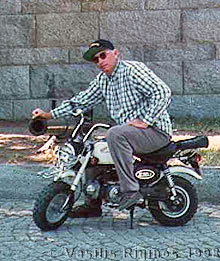
We left Faneromeni at 7:30 AM with the motorbike and took the small ferry boat across the Dardanelles to the North side. We then drove about 30 km to the monument of the British soldiers who were killed in the infamous battle of Gallipoli at World War I, when more than 100,000 soldiers were killed and buried here. The ride was through a heavily wooded area which, being a “Mili Park” (national park), is unspoiled and beautiful. The British monument was very moving. The names of all the units that fell during the battle were inscribed. Among them were a Greek and an Egyptian unit. There were also many Gurka and Burmese who were killed so far away from their home.
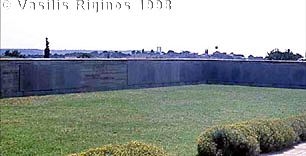
|
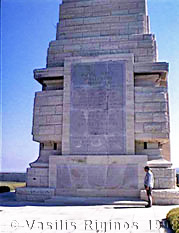
|
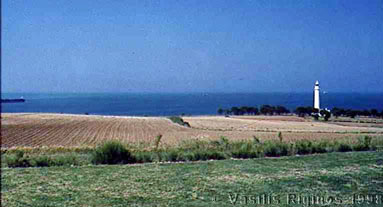
We then drove to the very large Turkish monument. Again it was very touching. I was particularly moved by the magnanimous words of Kemal Atatürk acknowledging the heroism not only of the Turkish soldiers but their enemies as well:
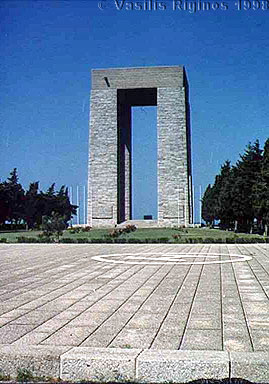
Those English, French, Australian,
New Zealand and Indian heroes who shed blood on the soil
of this country
Here you are in the soil of a friendly country
Rest in peace.
You are side by side and lying together with
the Mehmetcik’s.
You, the mothers, who sent their
sons to war from far away countries!
wipe away your tears, Your sons are lying on
our bosom.
They are at peace and they will rest in peace
After having lost their lives on this land.
They have become our sons as well!K. ATATÜRK
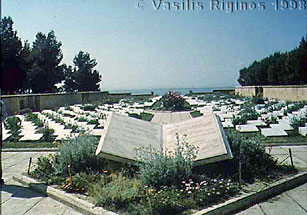
Back on board we asked Ali to make us a wooden base for the head so that its pump will not get wet. While waiting for Ali to finish the base we did some shopping and made all the preparations for departure. We also rewired the infernal Navtex in another futile attempt in trouble-shooting.